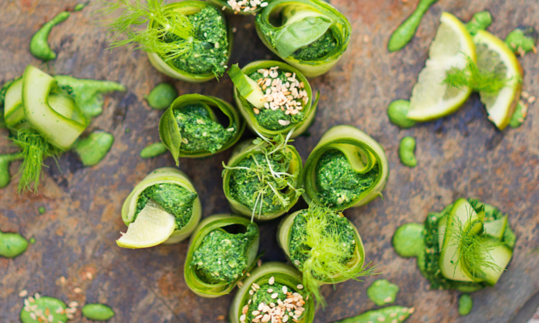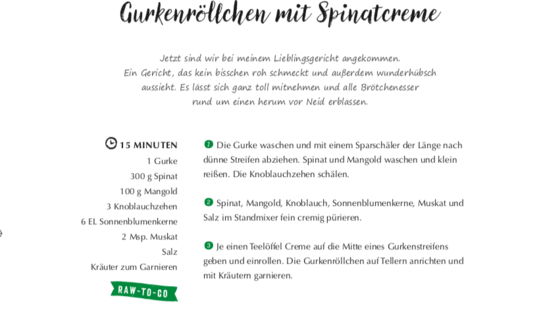Cucumber rolls with chard and spinach cream
raw-vegan
Ingredients (for servings, )
| For the cucumber strips | |
|---|---|
| 1 | Cucumbers, raw (organic?) (16 oz) |
| For the spinach cream | |
| 11 oz | Spinach, raw (vegetable spinach) |
| 3 ½ oz | Swiss chard / chard (raw, organic?) |
| 3 cloves | Garlic (organic?) (0.32 oz) |
| 6 tbsp | Sunflower seeds, raw (organic?) (2.1 oz) |
| 2 Msp. | Nutmeg, ground or grated (raw, organic?) (0.02 oz) |
| 1 dash | Table salt (table salt, raw?, organic?) (0.01 oz) |
Equipment
- blender
- vegetable peeler
Type of preparation
- chop or grind
- food preparation without heating
- purée
- remove the skin
Preparation
preparation (including cucumber strips)
Wash the cucumber(s) and use a vegetable peeler to peel them lengthways into strips. Wash the spinach and chard and tear them into small pieces. Peel the garlic cloves.For the spinach cream
Puree the spinach, chard, garlic, sunflower seeds, nutmeg and salt in a blender until finely creamy.Finish and serve
Place a teaspoon of spinach cream in the middle of each cucumber strip and roll it up.Arrange the cucumber rolls on plates and garnish with herbs.
|
Nutritional Information per person
Convert per 100g
|
2000 kcal | |
|---|---|---|
| Energy | 262 kcal | 13.1% |
| Fat/Lipids | 16 g | 23.6% |
| Saturated Fats | 1.6 g | 8.0% |
| Carbohydrates (inc.dietary fiber) | 23 g | 8.6% |
| Sugars | 5.8 g | 6.5% |
| Fiber | 8.0 g | 31.9% |
| Protein/Albumin | 13 g | 26.4% |
| Cooking Salt (Na:310.6 mg) | 789 mg | 32.9% |
| Essential micronutrients with the highest proportions | per person | 2000 kcal | |
|---|---|---|---|
| Vit | Vitamin K | 1'177 µg | 1'569.0% |
| Vit | Folate, as the active form of folic acid (née vitamin B9 and | 382 µg | 191.0% |
| Vit | Vitamin E, as a-TEs | 15 mg | 122.0% |
| Min | Manganese, Mn | 2.4 mg | 119.0% |
| Vit | Vitamin A, as RAE | 869 µg | 109.0% |
| Min | Copper, Cu | 0.93 mg | 93.0% |
| Vit | Vitamin C (ascorbic acid) | 65 mg | 82.0% |
| Elem | Potassium, K | 1'576 mg | 79.0% |
| Elem | Magnesium, Mg | 288 mg | 77.0% |
| Prot | Tryptophan (Trp, W) | 0.19 g | 75.0% |
Detailed Nutritional Information per Person for this Recipe
The majority of the nutritional information comes from the USDA (US Department of Agriculture). This means that the information for natural products is often incomplete or only given within broader categories, whereas in most cases products made from these have more complete information displayed.
If we take flaxseed, for example, the important essential amino acid ALA (omega-3) is only included in an overarching category whereas for flaxseed oil ALA is listed specifically. In time, we will be able to change this, but it will require a lot of work. An “i” appears behind ingredients that have been adjusted and an explanation appears when you hover over this symbol.
For Erb Muesli, the original calculations resulted in 48 % of the daily requirement of ALA — but with the correction, we see that the muesli actually covers >100 % of the necessary recommendation for the omega-3 fatty acid ALA. Our goal is to eventually be able to compare the nutritional value of our recipes with those that are used in conventional western lifestyles.
| Essential fatty acids | per person | 2000 kcal |
|---|---|---|
| Linoleic acid; LA; 18:2 omega-6 | 7.1 g | 71.0% |
| Alpha-Linolenic acid; ALA; 18:3 omega-3 | 0.24 g | 12.0% |
| Essential amino acids | per person | 2000 kcal |
|---|---|---|
| Tryptophan (Trp, W) | 0.19 g | 75.0% |
| Threonine (Thr, T) | 0.55 g | 59.0% |
| Isoleucine (Ile, I) | 0.69 g | 56.0% |
| Valine (Val, V) | 0.75 g | 47.0% |
| Phenylalanine (Phe, F) | 0.65 g | 42.0% |
| Leucine (Leu, L) | 0.98 g | 40.0% |
| Lysine (Lys, K) | 0.67 g | 36.0% |
| Methionine (Met, M) | 0.25 g | 27.0% |
| Vitamins | per person | 2000 kcal |
|---|---|---|
| Vitamin K | 1'177 µg | 1'569.0% |
| Folate, as the active form of folic acid (née vitamin B9 and | 382 µg | 191.0% |
| Vitamin E, as a-TEs | 15 mg | 122.0% |
| Vitamin A, as RAE | 869 µg | 109.0% |
| Vitamin C (ascorbic acid) | 65 mg | 82.0% |
| Vitamin B6 (pyridoxine) | 0.89 mg | 64.0% |
| Thiamine (vitamin B1) | 0.65 mg | 59.0% |
| Biotin (ex vitamin B7, H) | 27 µg | 55.0% |
| Riboflavin (vitamin B2) | 0.52 mg | 37.0% |
| Niacin (née vitamin B3) | 4.0 mg | 25.0% |
| Pantothenic acid (vitamin B5) | 1.1 mg | 19.0% |
| Essential macroelements (macronutrients) | per person | 2000 kcal |
|---|---|---|
| Potassium, K | 1'576 mg | 79.0% |
| Magnesium, Mg | 288 mg | 77.0% |
| Phosphorus, P | 357 mg | 51.0% |
| Sodium, Na | 311 mg | 39.0% |
| Calcium, Ca | 243 mg | 30.0% |
| Essential trace elements (micronutrients) | per person | 2000 kcal |
|---|---|---|
| Manganese, Mn | 2.4 mg | 119.0% |
| Copper, Cu | 0.93 mg | 93.0% |
| Iron, Fe | 7.3 mg | 52.0% |
| Selenium, Se | 19 µg | 35.0% |
| Zinc, Zn | 3.0 mg | 30.0% |
| Iod, I (Jod, J) | 19 µg | 12.0% |
| Fluorine, F | 5.2 µg | < 0.1% |
The cucumber rolls with chard and spinach cream have a very high content of vitamin K, folic acid and vitamin A.
Portion information: The amount of ingredients designed for 2 people is sufficient for 2 main courses or correspondingly more starter portions.
Nutrient profile: This dish has an extremely high vitamin K content thanks to the spinach and chard. According to GDA guidelines, one portion of this recipe covers more than the average daily requirement of vitamin K, folic acid, vitamin E and vitamin A as well as manganese. The ratio between linoleic acid (LA) and alpha-linolenic acid (ALA) is 29:1, which is significantly higher than the recommended maximum ratio of 5:1, due to the sunflower seeds.
Health: For health reasons, we have created an alternative recipe with variations in the ingredients. Please read the link behind this motivation: Vegans often eat unhealthily. Avoidable nutritional errors .
Spinach: Spinach is rich in vitamins (especially vitamin K, folic acid, vitamin A and vitamin C), protein and minerals. Although spinach has a high iron content among vegetables, the iron content is not exceptionally high. Despite the high oxalic acid content, consuming raw spinach in reasonable amounts is not harmful to health.
Swiss chard: Both the stems and the leaves of Swiss chard are edible. It tastes like spinach, but is more intense and bitter. Swiss chard contains a lot of vitamin K, but also vitamin C, vitamin A and vitamin E, as well as sodium, magnesium, potassium and iron. Like spinach, Swiss chard has a high oxalic acid content.
Oxalic acid and kidney stones: Kidney stones are stone-like deposits in the calyx system of the kidney and in the renal pelvis. These can form due to the crystallization of certain substances such as calcium oxalate and uric acid. Reasons for this include the presence of these substances in increased concentrations, pH changes in the urine, drainage obstructions or urinary tract infections. For this reason, people at risk of developing kidney stones should drink enough fluids and not eat too large quantities of foods containing oxalic acid (parsley, purslane, cassava, amaranth, spinach or chard). This also applies to people with hyperabsorption (= very high absorption) of oxalate or hyperoxaluria (high increase and increased excretion of oxalic acid in the urine). Oxalic acid also makes it difficult to absorb iron, which is why iron therapy should not be used to take an iron tablet with the above-mentioned food.
Recommended consumption of spinach: Spinach should not be stored at room temperature for long periods (around a week). Spinach contains a lot of nitrate, which bacteria convert into harmful nitrite. This can cause problems, especially in children, as it impairs the transport of oxygen in the body and the effects depend on both the amount consumed and body weight.
There are also 'fresh', packaged spinach leaves in plastic bags. However, the industry has to treat them heavily to ensure they last longer, as germs multiply quickly under the plastic. Vitamins also last less time than in really fresh spinach.
Salt content: Since salt requirements vary from person to person, no amount of salt is specified here. However, we recommend keeping the amount of salt as low as possible. Swiss chard naturally contributes to a higher salt content, so we left it at a pinch.
Herbs such as dill, cress and basil, as well as sesame seeds, are suitable for garnishing.





